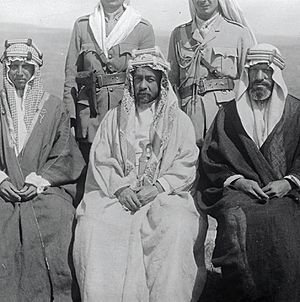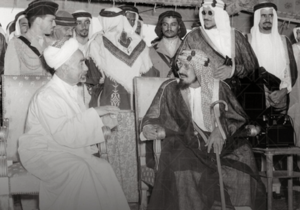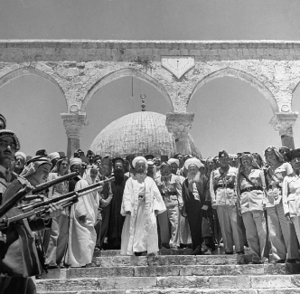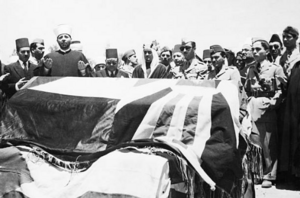Abdullah I of Jordan facts for kids
Quick facts for kids
|
|
|---|---|
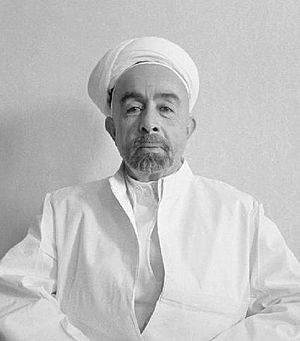
Portrait by Cecil Beaton, c. 1939-45
|
|
| King of Jordan | |
| Reign | 25 May 1946 – 20 July 1951 |
| Predecessor | Himself as Emir of Transjordan |
| Successor | Talal bin Abdullah |
| Emir of Transjordan | |
| Reign | 11 April 1921 – 25 May 1946 |
| Predecessor | Office established |
| Successor | Himself as King of Jordan |
| Born | 2 February 1882 Mecca, Hejaz Vilayet, Ottoman Empire |
| Died | 20 July 1951 (aged 69) Jerusalem, West Bank, Jordan |
| Burial | Raghadan Palace, Amman, Jordan |
| Spouse |
Musbah bint Nasser
(m. 1904)Suzdil Khanum
(m. 1913)Nahda bint Uman
(m. 1949) |
| Issue |
|
| House | Hashemite |
| Father | Husayn bin Ali |
| Mother | Abdiyya bint Abdullah |
| Military career | |
| Allegiance |
|
| Service/ |
|
| Years of service | 1916–1951 |
| Battles/wars |
|
Abdullah I bin Al-Hussein (born February 2, 1882 – died July 20, 1951) was a very important leader in the Middle East. He ruled Jordan from 1921 until 1951. First, he was the Emir (a type of prince or ruler) of Transjordan, which was under British protection.
In 1946, Transjordan became an independent country, and Abdullah became its first King. He was part of the Hashemite family, which has ruled Jordan since 1921. This family traces its roots back to the Prophet Muhammad.
Abdullah was born in Mecca, a holy city in what was then the Ottoman Empire. He was the second son of Hussein bin Ali, who was the Sharif of Mecca. Abdullah studied in Istanbul and Hejaz. He was involved in politics early on, even serving in the Ottoman parliament. During World War I, he worked with Britain to lead the Great Arab Revolt against Ottoman rule. He even led some attacks himself.
After the war, Abdullah became the Emir of Transjordan in 1921. He kept his alliance with the British during World War II. After Transjordan gained independence in 1946, he became King. He played a key role in the 1948 Arab–Israeli War, leading Jordan's forces and taking control of the West Bank. King Abdullah was assassinated in Jerusalem in 1951. His oldest son, Talal, became the next King.
Contents
Early Life and Political Beginnings
Abdullah's father, Hussein bin Ali, became the Grand Sharif of Mecca in 1910, with British support. The next year, Abdullah became a representative for Mecca in the Ottoman parliament. He helped his father communicate with the Ottoman government. In 1914, Abdullah secretly visited Cairo to meet with Lord Kitchener to discuss British support for his father's plans in Arabia.
Role in the Arab Revolt
Abdullah stayed in touch with the British during World War I. In 1915, he encouraged his father to talk with Sir Henry McMahon, a British official in Egypt. These talks were about Arab independence from Turkish rule and led to the Arab Revolt against the Ottoman Empire.
During the Arab Revolt (1916–1918), Abdullah commanded the Arab Eastern Army. He began by attacking the Ottoman army in Ta'if in June 1916. His forces were mostly tribesmen, and they laid siege to the town. He later received help from Egypt. Abdullah also helped besiege Medina and once captured a large amount of gold from an Ottoman convoy. He also worked with French Captain Muhammand Ould Ali Raho to damage the Hejaz Railway.
Creating the Emirate of Transjordan
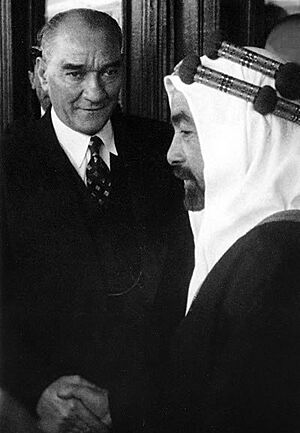
After French forces took over Damascus in 1920, Abdullah's brother Faisal was forced to leave. Abdullah then moved his forces from Hejaz into Transjordan. He hoped to free Damascus, where his brother had been named King. However, Winston Churchill invited Abdullah to a meeting in Cairo in 1921. Churchill convinced Abdullah not to attack the French, as their forces were stronger.
Abdullah had been offered the role of King of Iraq in 1920 but turned it down. His brother Faisal, who had just lost Syria, then accepted it. Abdullah went to Transjordan and was welcomed by the people. He established an emirate there.
Building the New State
In 1928, Abdullah created a council to help make laws, but he still held most of the power. He worked to build Transjordan with the help of a special force called the Arab Legion, led by British officers. During World War II, Abdullah was a loyal ally to Britain. He kept order in Transjordan and helped stop an uprising in Iraq that supported Germany. The Arab Legion also helped in Iraq and Syria.
Abdullah worked with Britain to gain independence for Transjordan. On May 25, 1946, the Hashemite Kingdom of Transjordan became independent. It was later renamed the Hashemite Kingdom of Jordan in 1949. On the day of independence, Abdullah was crowned King in Amman.
King Abdullah's Goals
Abdullah was seen as a moderate leader by Western countries. He had a dream of creating a "Greater Syria," which would include Transjordan, Syria, Lebanon, and Palestine, all under Hashemite rule. Because of this, many other Arab countries did not trust him. They worried he might threaten their own independence.
In 1937, Abdullah supported a plan to divide Palestine into a small Jewish state and a larger Arab area that would join Transjordan. The Arabs in Palestine and nearby countries did not like this plan, but Jewish leaders accepted it, though with some hesitation. This plan was never put into action. In 1947, when the United Nations proposed dividing Palestine into Jewish and Arab states, Abdullah was the only Arab leader who supported it.
Abdullah even had secret meetings with Jewish leaders to discuss how Palestine could be divided. He wanted to add the Arab parts of Palestine to Transjordan. He even suggested creating a Jewish area within his kingdom. However, the 1948 Arab–Israeli War began.
Role in the 1948 Arab–Israeli War
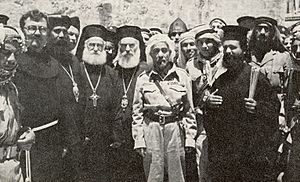
Abdullah decided to join other Arab nations in the war. He wanted to gain more land and especially wanted to take Jerusalem. He saw himself as the main commander of the Arab forces. His forces, led by British commander Glubb Pasha, fought around Jerusalem.
Assassination
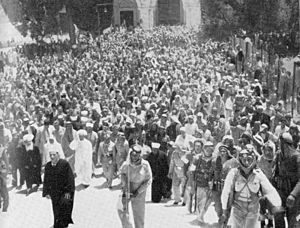
On July 20, 1951, King Abdullah was visiting the Al-Aqsa Mosque in Jerusalem for Friday prayers. A Palestinian gunman shot and killed him. His grandson, Prince Hussein, who was with him, was also hit by a bullet. However, a medal on Hussein's chest deflected the bullet and saved his life.
The assassin was a 21-year-old tailor's apprentice named Mustafa Shukri Ashu, who was killed by the king's bodyguards. Later, several people were arrested and tried in connection with the assassination. Some of them were sentenced to death. King Abdullah was buried at the Royal Court in Amman.
Succession After Abdullah's Death
Abdullah had two sons: Talal and Prince Naif. Talal was the older son and was expected to become King. However, Talal had some health issues and a difficult relationship with his father.
After Abdullah's assassination, Talal was supposed to become King. But because he was receiving medical treatment abroad, his brother Prince Naif acted as regent (a temporary ruler). Some people thought Naif wanted to become King himself. However, with British support, Talal eventually returned to Jordan and became King on September 6, 1951. Because King Talal was mentally ill, his son Prince Hussein later became the effective ruler at a young age.
Marriages and Children
Abdullah was married three times.
- In 1904, he married his first wife, Musbah bint Nasser. They had three children:
- Princess Haya (1907–1990)
- King Talal (1909–1972)
- Princess Munira (1915–1987)
- In 1913, he married his second wife, Suzdil Khanum. They had two children:
- Prince Nayef bin Abdullah (1914–1983)
- Princess Maqbula (1921–2001)
- In 1949, he married his third wife, Nahda bint Uman. They had one child:
- Princess Naifeh (born 1950)
Honours
 Francoist Spain: Grand Cross of the Order of Military Merit (with white distinctive), (1949)
Francoist Spain: Grand Cross of the Order of Military Merit (with white distinctive), (1949)
Images for kids
-
The Emir with Sir Herbert Samuel (center) and T. E. Lawrence (left), Amman Airfield, 1921
-
The Emir at the Cairo Conference with T. E. Lawrence, Air Marshal Sir Geoffrey Salmond and Sir Wyndham Deedes, March 1921
-
The Emir with Sir Herbert Samuel and Mr. and Mrs. Winston Churchill at Government House reception in Jerusalem, March 28, 1921
-
Emir Abdullah at his Amman camp with John Whiting of the American Colony (businessman, photographer, intelligence officer) and staff, 1921
See also
 In Spanish: Abd Allah ibn Husayn para niños
In Spanish: Abd Allah ibn Husayn para niños



